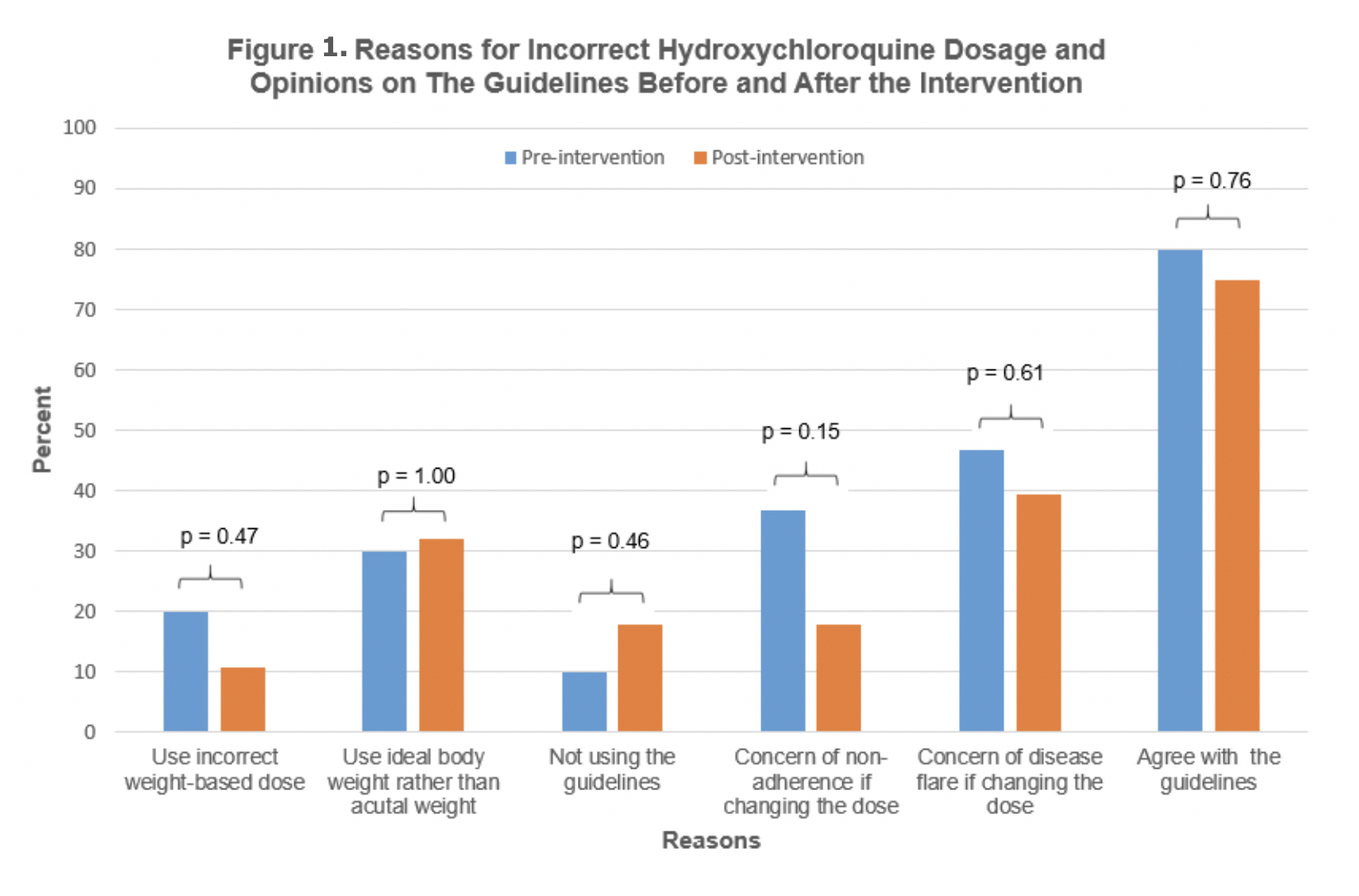Session Information
Session Type: Poster Session D
Session Time: 9:00AM-11:00AM
Background/Purpose: One rare but devastating adverse event related to the use of hydroxychloroquine (HCQ) is retinal toxicity. Retinal toxicity rates from HCQ can be as high as 7.5% and is dose-related. In 2016, the American Academy of Ophthalmology (AAO) issued weight-based guidelines recommending that daily dosing not exceed 5 mg/kg/day. However, there are concerns from those prescribing this medication that dose reduction might decrease the benefit of this medication. We wanted to analyze HCQ prescribing habits and opinions on these guidelines in our academic institution. We also conducted a prospective, non-controlled, quality improvement study to examine if a tool in the electronic medical record (EMR) affected compliance with these guidelines or affected provider’s perspectives on these guidelines.
Methods: Survey data was collected from prescribers. Chart review on patients prescribed HCQ, was collected. Survey data included: awareness of guidelines, self-reported compliance with guidelines, and opinion of guidelines. All data were collected pre-intervention (June 2017 – January 2019) and post-intervention (March 2019 – April 2020). In January 2019 we released an EMR tool which prompted guideline-based weight-based dosing whenever HCQ was prescribed. Results were analyzed using descriptive statistics for demographic data and Fisher’s exact tests for comparisons of proportions between groups.
Results: Pre-intervention: We reviewed 1,128 rheumatology charts. 350 (31.0%) rheumatology patients were prescribed HCQ >5.0 mg/kg/day. We reviewed 282 dermatology charts. 112 (39.7%) dermatology patients were prescribed HCQ >5.0 mg/kg/day. Combining rheumatology and dermatology patients, 462 (32.8%) were prescribed HCQ >5.0 mg/kg/day (Table 1). Post-intervention: We analyzed 1,158 rheumatology charts. 267 (23.1%) rheumatology patients were prescribed HCQ >5.0 mg/kg/day. We reviewed 106 dermatology charts. 28 (26.4%) dermatology patients were prescribed HCQ >5.0 mg/kg/day. Combining rheumatology and dermatology patients, 295 (23.3%) were prescribed HCQ >5.0 mg/kg/day (Table 2). Post-intervention, there was a 9.5% increase in patients prescribed HCQ ≤5 mg/kg/day (p-value < 0.0001). Pre-intervention, we compiled 18 surveys from rheumatology and 12 surveys from dermatology; post-intervention, we compiled 16 surveys from rheumatology and 12 surveys from dermatology (Fig 1). Post-intervention, there were reductions in the number of rheumatologists who incorrectly identified the guideline-based weight-based dosing recommendation of HCQ; there was no change in dermatologists. Combined, there was an overall reduction but not of statistical significance (p=0.47).
Conclusion: Our research finds ongoing hesitation towards compliance with the 2016 AAO recommendations for HCQ weight-based dosing. There is ongoing unfamiliarity with the details of the recommendations therein. Prescribed HCQ doses in practice often exceeded the recommended daily dose. Finally, our research shows that appropriate EMR intervention, prompting appropriate and safe weight-based dosing of HCQ, can improve compliance with these guidelines. We believe that this will lead to improved patient safety over the lifetime.
To cite this abstract in AMA style:
Overbury R, Pupaibool J, Hansen C, Lebiedz-Odrobina D. Hydroxychloroquine Prescribing Habits and Provider Opinion on Dosing Guidelines in the Rheumatology and Dermatology Practices of an Academic Institution [abstract]. Arthritis Rheumatol. 2020; 72 (suppl 10). https://acrabstracts.org/abstract/hydroxychloroquine-prescribing-habits-and-provider-opinion-on-dosing-guidelines-in-the-rheumatology-and-dermatology-practices-of-an-academic-institution/. Accessed .« Back to ACR Convergence 2020
ACR Meeting Abstracts - https://acrabstracts.org/abstract/hydroxychloroquine-prescribing-habits-and-provider-opinion-on-dosing-guidelines-in-the-rheumatology-and-dermatology-practices-of-an-academic-institution/



